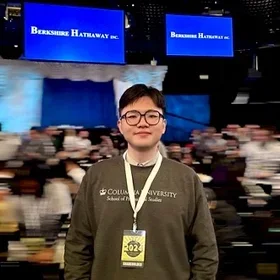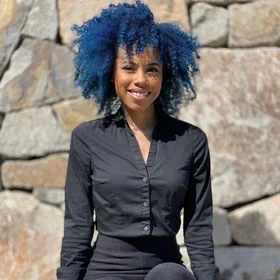When Nancy Choe’s father was diagnosed with colon cancer, she witnessed first-hand his emotional suffering and mistrust of the medical establishment while he received treatment. He, along with patients in a similar situation, believed that their stories went unheard. An experienced psychotherapist, Nancy began to search for solutions; what she found led her to the groundbreaking work of Dr. Rita Charon and the Narrative Medicine program at Columbia University.
Nancy opted for the program’s Certification of Professional Achievement offering and went on to finish her dissertation on using art prompts in narrative medicine. She reflected on what inspired her to infuse art therapy with narrative medicine and how Columbia’s program continues to influence her practice.
How did you learn about the Columbia Certification of Professional Achievement in Narrative Medicine Program?
My father passed away from colon cancer three years ago. During his illness, he relied on a group that shared a lot of misinformation because they mistrusted doctors and the healthcare system. The mistrust was based on their perception that healthcare professionals had no interest in listening to patient stories, and didn’t care for them. This alarmed me a great deal, and I wanted to find out how this perception affected treatment, engagement, and retention. My research on healthcare and empathy led me to articles about narrative medicine, and then to Dr. Rita Charon’s work and her teaching at Columbia University.
I was thrilled to find out that Columbia University had a Certification of Professional Achievement in Narrative Medicine program. It was the only program that was interdisciplinary and rigorous, yet flexible for working professionals like me. I was working in private practice as a psychotherapist (and still am) when I enrolled at Columbia. I was also facilitating group art therapy sessions for a residential treatment program. The CPA in Narrative Medicine was asynchronous, so it wasn’t too tricky to fit the courses into my busy schedule.
What attracted you to narrative medicine in particular?
Narrative medicine has three primary values: attention, representation, and affiliation. Clinicians are trained to pay attention with humility to the stories of themselves and others, to make the unheard and unnoticed visible, and to connect with aspects of themselves and others. I loved how all of this was done through activities that promote reflection, curiosity, dialogue, and creativity rather than using a didactic method of learning.
What role does narrative medicine play in your work?
I think narrative medicine will always play a role in my practice and research. I currently use elements of narrative medicine practice in group art therapy sessions. Narrative medicine practice has a clear and replicable structure that can be modified to fit the needs of the participants. I encourage group members to do close viewings of their artwork and write short reflections or poems. This approach fosters growth and meaning-making. I also completed an exploratory research study about the impact of using art prompts in an online narrative medicine workshop. I used an art therapy-based model, the Expressive Therapies Continuum (ETC), to guide the selection of art materials and media for the art prompts. The study revealed that these prompts gave participants an opportunity to use their sensorimotor functions, enter a flow-like state, be challenged and inspired by novelty and uncertainty, and experience a sense of play. I hope to report the results in a publication soon.
My narrative medicine training at Columbia gave me more tools to work with in art therapy, curriculum development in arts in healthcare, and community work. Last year at the American Art Therapy Association’s Annual Conference, I led a presentation on the use of ekphrasis (writing a poetic response to visual art) in group art therapy and supervision and introduced narrative medicine’s close reading/viewing method. So many of my fellow practitioners reached out to me to express interest in learning more about narrative medicine. I also plan to develop an online, arts-based narrative medicine workshop for clinicians that focuses on growth and well-being, based on the outcome of my research study on art prompts. I think the program has helped me think and practice in more interdisciplinary and transdisciplinary ways.
Who was your favorite Columbia professor(s) or what was your favorite course?
This is a difficult question because I learned so much in each course, and they were all fabulous! I think I learned the most about my creative sensibility in Joseph Eveld’s and Nellie Hermann’s Writing Creatively course. I’d always considered myself a poor writer, so I was intimidated when I entered this course. We were exposed to a variety of genres and participated in weekly writing workshops—thankfully, nobody was a brutal critic. Instead, Joseph and the group offered constructive feedback, which helped me to translate my creative ideas into words. I found myself experimenting with words and syntax the same way I use art materials and media. I was surprised at how much I enjoyed the creative process of writing.
I also appreciated Deepu Gowda’s and Anne Cunney’s course in Pedagogy: Goals, Methods, Contexts. The course trains students to develop and facilitate an effective narrative medicine workshop. Despite running arts-based groups for a long time, I still learned a lot, particularly how to evaluate what works and what doesn’t. My last course in the program was Social Justice: Narratives of Inequity with Maura Spiegel and Courtni Jeffers. I took this course in Spring 2021, and the timing was perfect. It allowed me to reflect on 2020 and the gap between diversity, equity, and inclusion (DEI) intentions and the ongoing reality. As a result, I felt more empowered and responsible for closely listening to stories about social justice issues, and to address them in the most meaningful ways.
Describe some of the challenges you encounter in your work and the value you are able to bring as a result of the knowledge you’ve gained at Columbia.
I no longer work at an agency or hospital, but time is precious in a busy clinical setting. Many healthcare professionals think there’s not enough time to listen and connect with patients and colleagues. After completing the program, though, I realized that close listening and reflecting do not depend on length of time, but on one’s intention and level of engagement. One must be intentional about taking a stance of openness, curiosity, and acceptance. I try to remind myself of this in any difficult work situation.
What was your most valuable experience at Columbia?
The most valuable experience for me was making connections with people I would have never encountered on my own. Although the program is online, there is a definite community, and friendships are built. For instance, another student in the program became my doctoral study committee member. She’s a nurse, educator, and researcher, and she has been a great mentor to me. In my creative writing course, a physical therapist shared his short story with me to use in my research study as a close reading material. The narrative medicine program’s alumni network is also a great resource. Eleven alumni generously volunteered to be in my study about art prompts during the height of the pandemic and political instability. Finally, I think Cindy Smalletz, the CPA program director, has a powerful impact by modeling generosity and curiosity to everyone. My online Columbia experience brought me close to people from various fields. This has informed how I want to develop and structure online art therapy and arts-based groups in the future.


